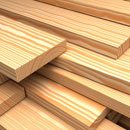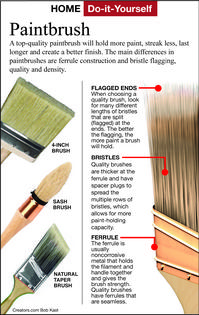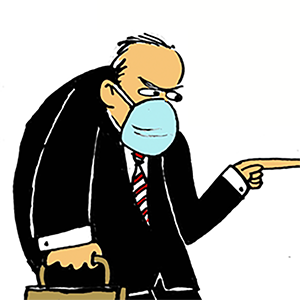Here's How: Proper Paintbrush for Each Project
Dear James: My kids want to jazz up their bedrooms with new wall colors. What are the best types of paintbrushes and rollers to use for the walls and window and door trim? -- Stephanie R.
Dear Stephanie: Nothing improves a room more than a quick coat of fresh paint and color. Your kids are going to love it. Let them choose the color to avoid any complaints from them later. After they choose their color, it's your turn to choose your tools. Walking through the painting aisle at your home center can be overwhelming. Luckily, most rows of brushes in the racks can be grouped into just a few categories, making your decisions easier.
The two basic types of brushes are natural and synthetic bristles. Natural bristles are made from animal hair, usually hog's, and should be used with oil-based paints, shellac or alkyd paint. The natural hair of these brushes ensures a smooth job because the split ends in the bristles hold more paint. Synthetic brushes are made from nylon, polyester or a combination of the two. These can be used with both oil- and water-based paints.
Higher quality brushes will have a natural taper with the longer bristles at the center. The shorter bristles should never end less than 1/2 inch from the tip of the longest bristles. Be sure to inspect the bristles of the brush well before purchasing. The tips of a natural bristled brush should have split ends. Synthetic bristles should look fuzzy.
Tap the aluminum band on the paintbrush to see if any bristles fall out. This band is called the ferrule, and it should be tightly wrapped around the brush handle. Less expensive brushes will lose their bristles, and a rusty ferrule may discolor the paint when dipped into the can. The ferrule should be attached with small screws, bands or rivets instead of just slip-fitted into place.
For painting around wood trim, use a sash brush. This is a brush that is about 1 1/2 inches wide and has angled bristles. The angled cut gives you an advantage when trying to paint around the trim. For other areas, use a 4-inch brush for larger coverage. Brushes larger than 4-inch are often too heavy and cumbersome to handle easily.
Rollers are a good way to save time, but they also use more paint. If you have a wall with no windows or doorways, a roller is a good choice. Rollers come in natural and synthetic materials, and ones with beveled edges give the best surface finish. Also check to make sure the roller has no visible seams.
Keeping your painting equipment clean will ensure that it will last for many years. Use paint thinner to clean brushes covered with oil-based paints and soap and water for water-based paints. Be sure to wear gloves when cleaning with paint thinner.
Wipe off as much paint as possible from the ferrule and the handle. Allow the brush to soak in a few inches of the cleaning agent. Comb the paintbrush with a wire brush from the ferrule outward to help remove paint from the bristles. Be sure to reshape the paintbrush after cleaning and store it in its original wrapper.
========
Send your questions to Here's How, 6906 Royalgreen Dr., Cincinnati, Ohio, 45244 or visit www.dulley.com. To find out more about James Dulley and read features by other Creators Syndicate writers and cartoonists, visit the Creators Syndicate website at www.creators.com.
Copyright 2025 Creators Syndicate Inc.






























Comments